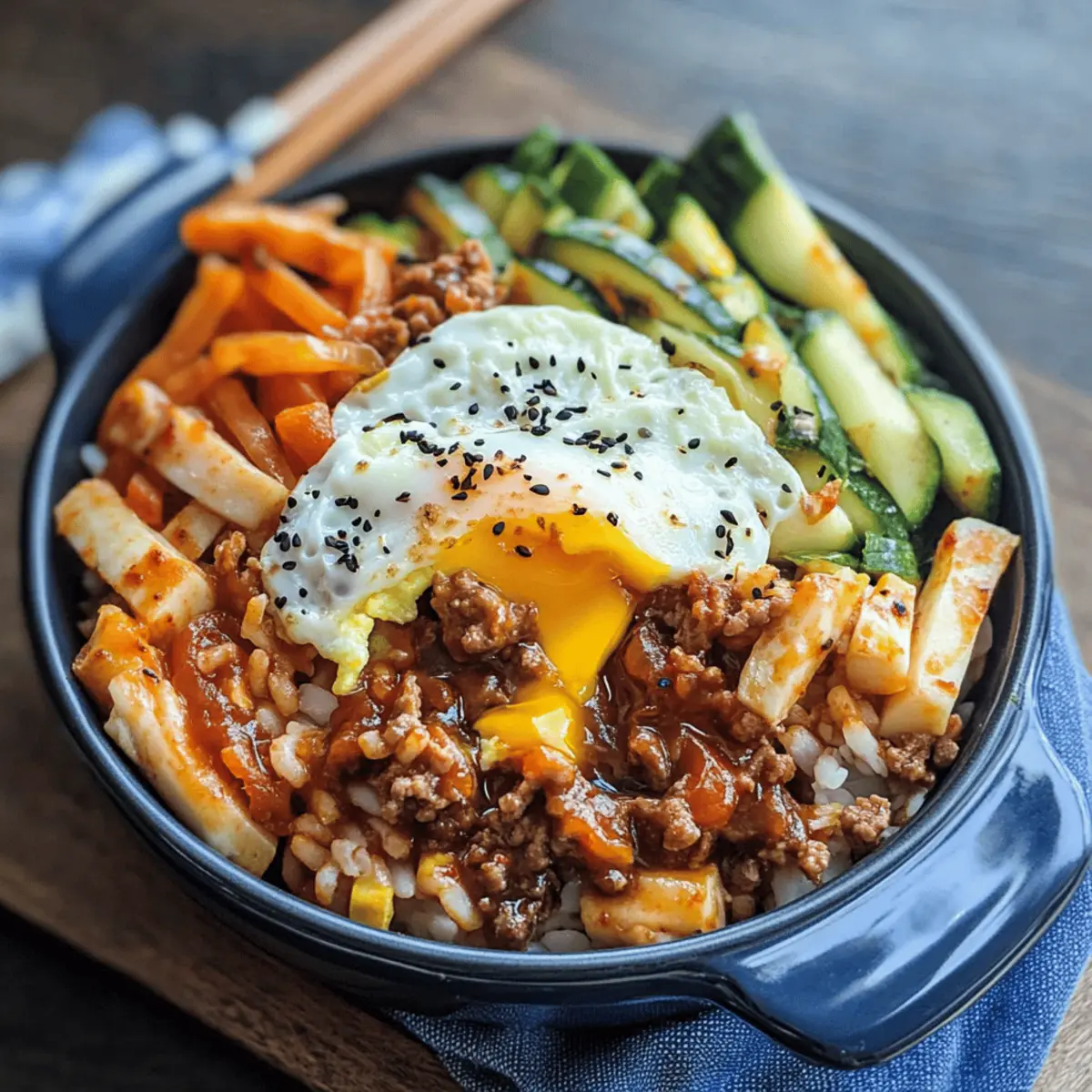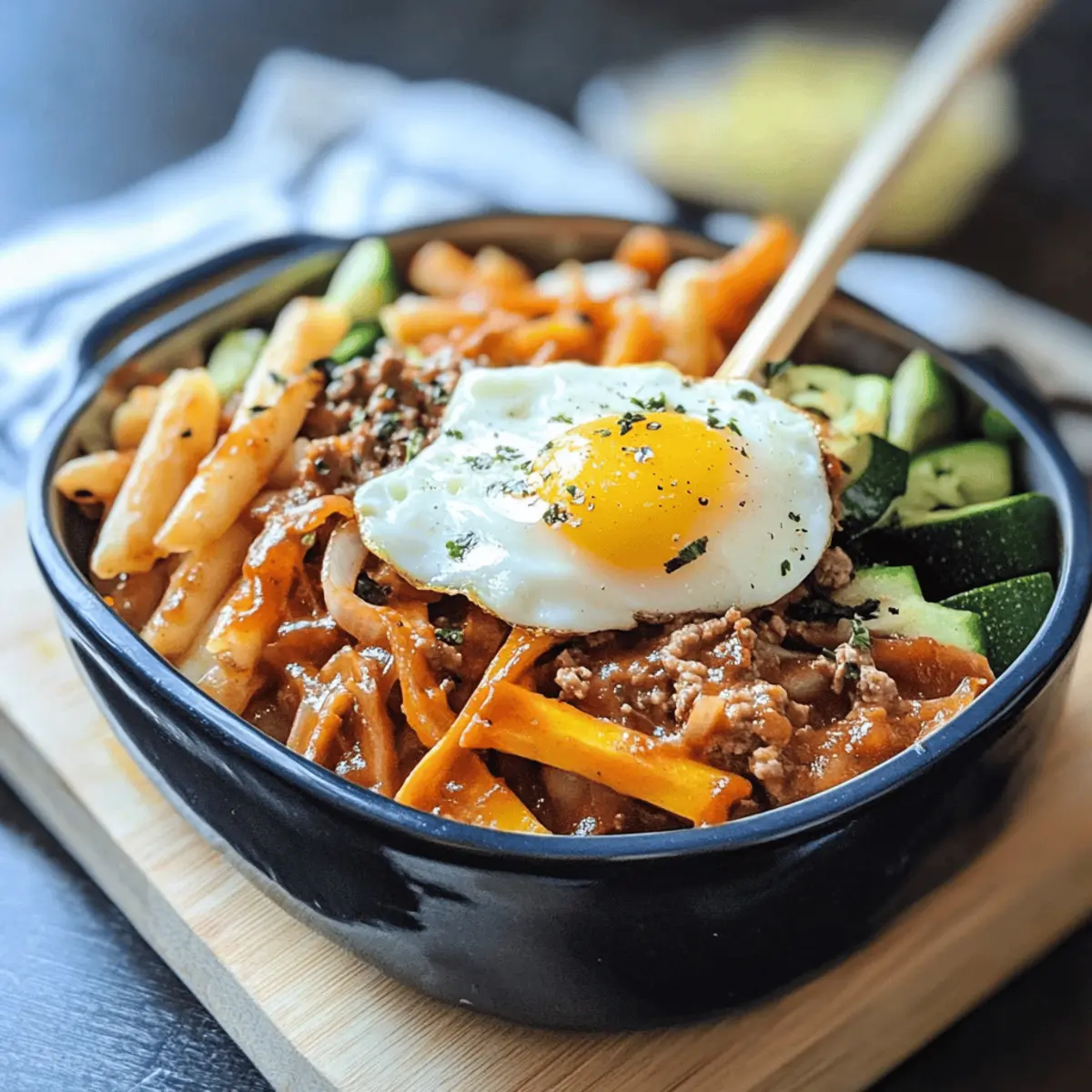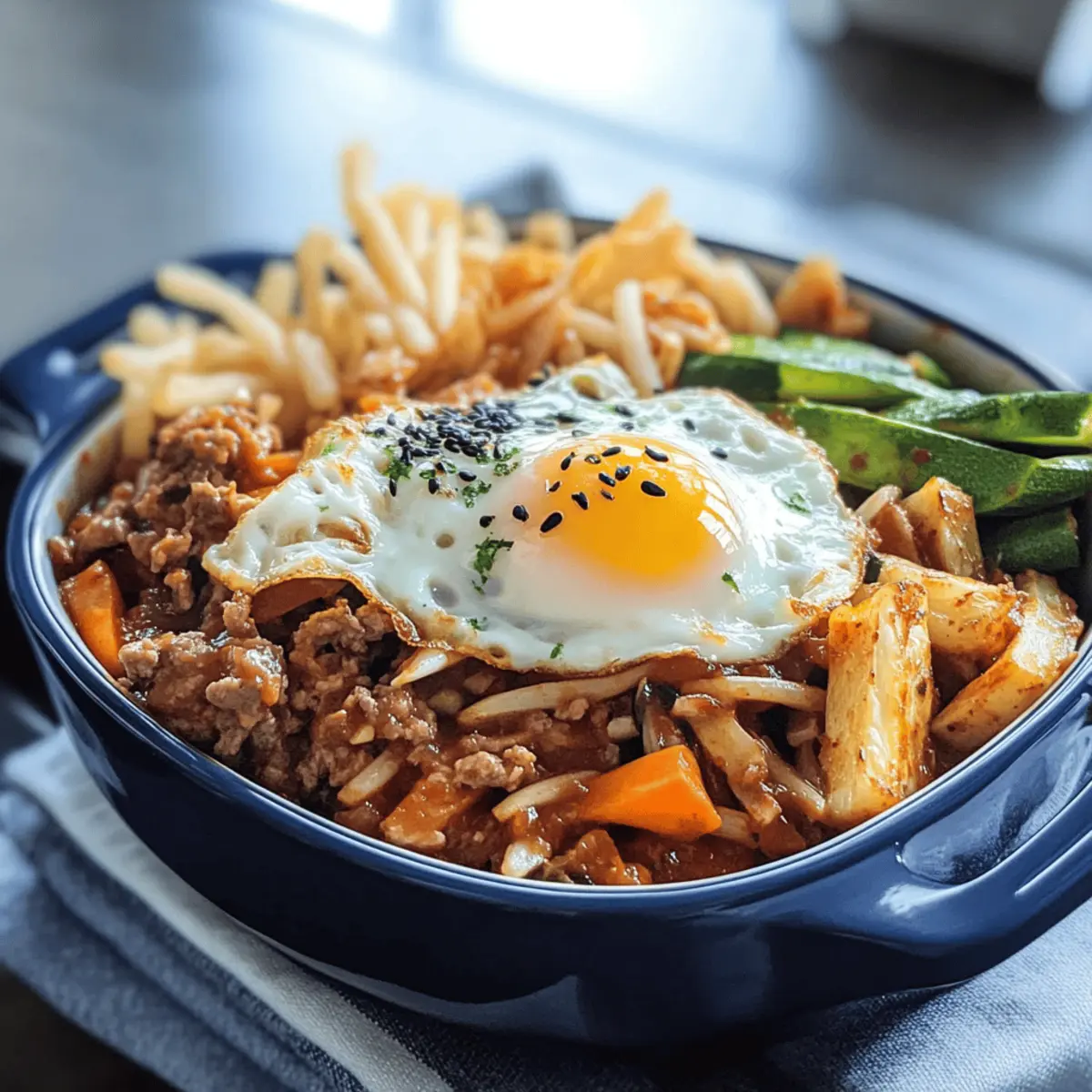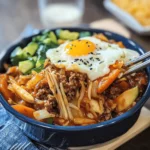There’s something truly captivating about the vibrant colors and bold flavors of Korean Bibimbap with Veggies and Egg. One afternoon, craving a meal that’s both nourishing and exciting, I tossed together a bowl bursting with fresh vegetables, perfectly cooked rice, and a sunny-side-up egg that oozes richness with every bite. What makes this dish a weeknight superstar is how effortlessly it balances wholesome ingredients with that signature kick of gochujang sauce—a harmony of spicy, sweet, and savory all in one bowl. Whether you’re a seasoned home cook or looking to break free from the monotony of fast food, Bibimbap invites you to create something beautiful, healthy, and deeply satisfying right in your own kitchen.

Why choose Korean Bibimbap with Veggies and Egg?
Vibrant and wholesome: This dish brims with colorful vegetables that nourish your body and delight your eyes. Flavor-packed simplicity: A perfect balance of spicy, sweet, and savory with gochujang sauce, bringing authentic Korean taste to your table. Effortless assembly: Quick to make yet impressive enough for any meal. Customizable: Easily adapt with your favorite veggies or proteins. Satisfying textures: Warm rice, crisp veggies, and a rich, runny egg create a perfect bite every time.
Korean Bibimbap with Veggies and Egg Ingredients
For the Rice Base
- Short-grain rice – Use sticky, slightly chewy rice to hold all the flavors together.
- Sesame oil – Adds a subtle nuttiness that complements the rice perfectly.
For the Veggie Mix
- Spinach – Blanched and seasoned lightly with garlic and sesame for freshness.
- Carrots – Julienne thin for a sweet crunch and vibrant color.
- Bean sprouts – Quickly blanched to keep a crisp texture and mild flavor.
- Zucchini – Sautéed gently to add tender, savory notes.
- Shiitake mushrooms – Provide earthy depth when sautéed with soy sauce and garlic.
For the Egg and Sauce
- Egg – Sunny-side-up with a runny yolk that enriches every bite of Bibimbap.
- Gochujang (Korean chili paste) – The signature spicy, sweet, and savory chili paste that defines the Korean Bibimbap with Veggies and Egg experience.
- Soy sauce – Adds umami and saltiness to balance flavors.
- Garlic – Freshly minced to awaken the palate with aromatic warmth.
- Sesame seeds – Toast lightly for a nutty crunch as a finishing touch.
How to Make Korean Bibimbap with Veggies and Egg
- Cook Rice: In a medium pot, rinse 1½ cups of short-grain rice until water runs clear, then cook with 1¾ cups water; bring to a boil, reduce heat, cover, and simmer 15 minutes until tender.
For the Veggie Mix:
- Blanch Spinach and Sprouts: Blanch 1 cup spinach and ¾ cup bean sprouts in boiling water for 1 minute, drain, then toss with ½ teaspoon sesame oil, minced garlic, and a pinch of salt until evenly coated.
- Sauté Carrots and Zucchini: In a skillet over medium heat, cook julienned carrots and sliced zucchini separately for 2 to 3 minutes each until just tender, seasoning lightly with soy sauce for a savory finish.
- Sauté Mushrooms: In the same skillet, add sliced shiitake mushrooms with soy sauce and minced garlic, cooking for 4 minutes until golden brown and aromatic, then set aside off heat.
For the Sauce:
- Mix Gochujang Sauce: Whisk together gochujang, soy sauce, sesame oil, sugar, and minced garlic in a small bowl until smooth and slightly glossy, adjusting spiciness to taste for perfect flavor balance.
- Fry Egg: Heat a little oil in a nonstick pan over medium heat, crack in the egg, and cook sunny-side-up for 2 to 3 minutes until whites are set and yolk stays runny.
- Assemble Bibimbap: Scoop warm rice into bowls, arrange each veggie portion and mushrooms neatly around, top with fried egg, drizzle sauce, and sprinkle toasted sesame seeds for a vibrant finish.
Optional: garnish with sliced green onions and kimchi on the side.
Exact quantities are listed in the recipe card below.

What to Serve with Korean Bibimbap with Veggies and Egg?
Elevate your Korean feast with delightful pairings that will resonate with every bite of this vibrant dish.
-
Kimchi: This classic fermented side adds zing and depth, perfectly complementing the fresh veggies and rich egg.
-
Sesame Spinach Salad: A light, savory salad with sesame oil and garlic that echoes the dish’s freshness, making for a bright contrast to the warm rice.
-
Korean Fried Chicken: Crunchy, crispy chicken with a sweet and spicy glaze harmonizes beautifully with the warmth and wholesome ingredients of Bibimbap.
-
Miso Soup: A warm, umami-rich broth that soothes the palate, balancing the bold flavors of Bibimbap and providing a comforting touch.
-
Korean Rice Cakes: Chewy and satisfying, these cakes enhance the meal’s texture and offer a subtle sweetness that rounds out the flavors.
-
Cucumber Kimchi: This refreshing twist on traditional kimchi brings a cooling crunch, perfect for taming any spice while delivering a tangy kick.
-
Jasmine Tea: A fragrant companion that refreshes the palate, jasmine tea serves as a fragrant, uplifting drink amidst bold flavors.
-
Mochi Ice Cream: For dessert, these delightful bites of sweet, chewy mochi filled with ice cream are a perfect sweet ending that balances the savory meal.
With these pairings, your Korean Bibimbap will shine like a culinary rainbow on your dinner table!
How to Store and Freeze Korean Bibimbap with Veggies and Egg
Fridge: Store any leftovers of your Korean Bibimbap in an airtight container for up to 3 days to maintain freshness.
Freezer: You can freeze the rice and veggie components in a sealed freezer bag for up to 2 months. Avoid freezing the egg or gochujang sauce.
Reheating: To reheat, thaw the rice and veggies overnight in the fridge, then warm them in a skillet. Cook a fresh egg on the side before serving for the best experience.
Assembling Freshly: For optimal flavor and texture, it’s best to reassemble your Bibimbap elements fresh, particularly the egg, to enjoy that rich runny yolk with every delicious bite.
Make Ahead Options
These Korean Bibimbap with Veggies and Egg are ideal for busy meal prep enthusiasts! You can prepare the rice and veggies up to 3 days in advance. Simply cook the rice, then let it cool completely before storing it in an airtight container in the refrigerator. Blanch the spinach and bean sprouts, sauté the carrots, zucchini, and shiitake mushrooms, allowing them to cool before refrigerating as well. To maintain quality, store the gochujang sauce separately to keep the flavors fresh. When you’re ready to enjoy your meal, simply reheat the rice and veggies, fry the egg, and assemble the Bibimbap for a fast, delightful dish that’s just as vibrant and delicious as when prepared fresh!
Korean Bibimbap with Veggies and Egg Variations
Feel free to explore these exciting twists on your beloved Bibimbap recipe!
-
Vegan Swap: Replace the egg with silken tofu or avocado for a creamy, plant-based option that enhances texture and flavor.
-
Spicy Twist: Add sliced jalapeños or a drizzle of hot sauce for an extra kick that brings heat to each bite. Just a little can elevate the dish to a new level!
-
Protein Boost: Stir in cooked chicken, beef, or tofu. Any protein will make your Bibimbap heartier and transform it into a complete meal, perfect for hungry diners.
-
Whole Grain Rice: Use brown rice or quinoa instead of short-grain rice for a nuttier flavor and added nutritional benefits, creating a more wholesome bowl.
-
Seasonal Veggies: Experiment with seasonal or locally sourced veggies, like bell peppers or asparagus, adding different colors and flavors to your dish.
-
Nutty Flavor: Toss in chopped peanuts or cashews for an unexpected crunch and rich, savory notes that contrast beautifully with the softness of the rice and egg.
-
Herbal Freshness: Incorporate fresh herbs like cilantro or Thai basil to add brightness and an aromatic twist, refreshing your Bibimbap experience with every bite.
-
Kimchi Kick: Blend in kimchi for added fermented flavor and a spicy zing, making each forkful a delight for your taste buds—it’s a true Korean classic!
Expert Tips for Korean Bibimbap with Veggies and Egg
- Perfect Rice Texture: Rinse the short-grain rice thoroughly until water is clear to remove excess starch and prevent clumping in your Bibimbap.
- Veggie Prep Balance: Blanch greens just until wilted and sauté other veggies lightly; overcooking dulls color and crunch essential for vibrant texture.
- Egg Cooking: Cook the sunny-side-up egg on medium heat and avoid flipping to preserve that rich, runny yolk that melds beautifully with the rice.
- Gochujang Sauce Adjustment: Start with less gochujang and gradually add more to suit your spice preference; it’s easier to increase heat than tone it down.
- Assembly Artistry: Arrange veggies separately around the bowl before topping with egg and sauce; it creates a visually stunning and Instagram-worthy presentation.
- Avoid Mixing Too Early: Let diners mix their Bibimbap at the table to enjoy the contrasting textures and fresh flavors optimally without sogginess.

Korean Bibimbap with Veggies and Egg Recipe FAQs
How do I choose the best vegetables for Korean Bibimbap with Veggies and Egg?
Look for fresh, crisp veggies with vibrant color—spinach should be bright green without dark spots; carrots firm and orange; zucchini tender but firm. Fresh shiitake mushrooms should smell earthy, not musty. Using fresh ingredients really brings the dish to life visually and flavor-wise!
What’s the best way to store leftover Bibimbap?
Store leftovers in an airtight container in the refrigerator for up to 3 days. Keep the rice and veggies together, but avoid storing the fried egg with them if possible, as the texture deteriorates quickly. Reheat veggies and rice gently on the stovetop for best results, then fry a fresh egg to top.
Can I freeze Korean Bibimbap with Veggies and Egg for later?
Absolutely! Freeze the cooked rice and veggie portions separately in tightly sealed freezer bags for up to 2 months. Avoid freezing the fried egg and gochujang sauce because their textures change unpleasantly. When ready, thaw veggies and rice overnight in the fridge, reheat gently on the stove, and cook a fresh egg for that perfect runny yolk.
What if my rice turns out too sticky or mushy?
This is a common hiccup! To prevent mushy rice, rinse the short-grain rice thoroughly until the water runs clear before cooking to remove excess starch. Add the exact water ratio (1¾ cups water to 1½ cups rice), and cook covered on low heat. Fluff rice gently with a fork before assembling. If it’s already too sticky, try serving it as a warm base rather than mixing too vigorously in the bowl.
Is Korean Bibimbap with Veggies and Egg safe for pets or special diets?
While this dish is wholesome for humans, it’s best not to share it with pets due to ingredients like garlic, soy sauce, and gochujang, which can be harmful to dogs and cats. For food allergies, consider substituting soy sauce for tamari (gluten-free) or omitting eggs and mushrooms if sensitive. The recipe is naturally vegetarian, and you can easily make it vegan by swapping the egg for tofu or tempeh.

Easy Korean Bibimbap with Veggies and Egg – Flavor Packed Meal
Ingredients
Equipment
Method
- Rinse the rice until water runs clear, then cook with water; bring to a boil, reduce heat, cover, and simmer for 15 minutes until tender.
- Blanch spinach and bean sprouts in boiling water for 1 minute, drain, and toss with sesame oil, garlic, and salt.
- Sauté julienned carrots and zucchini for 2-3 minutes each until just tender, seasoning lightly with soy sauce.
- Sauté sliced shiitake mushrooms with soy sauce and minced garlic for 4 minutes until golden brown.
- Whisk together gochujang, soy sauce, sesame oil, sugar, and minced garlic until smooth.
- Fry the egg sunny-side-up in a nonstick pan for 2-3 minutes until whites are set and yolk stays runny.
- Scoop warm rice into bowls, arrange veggies and mushrooms, top with fried egg, drizzle sauce, and sprinkle sesame seeds.




